The Vela Supernova Remnant (Vela SNR) is the remnant of a supernova that occurred around 11,000 years ago in the southern constellation Vela. The remnant lies approximately 936 light-years away. It is one of the nearest supernova remnants to the Sun. It is associated with the Vela Pulsar, the brightest pulsar in the sky at radio frequencies.
The expanding cloud of material is also referred to as Gum 16. It has an apparent size of about 8 degrees and an apparent magnitude of 12. It is the remnant of a Type II supernova, a supernova event triggered by the core collapse of a star with at least 8 times the Sun’s mass. The remnant is travelling outwards at 1,200 km/s. It is almost 100 light-years across.
The Vela Supernova Remnant was created when a massive star shed its outer layers in a supernova event and its core collapsed into a neutron star. The neutron star, the Vela Pulsar, packs a mass comparable to that of the Sun into a diameter of only a few kilometres.
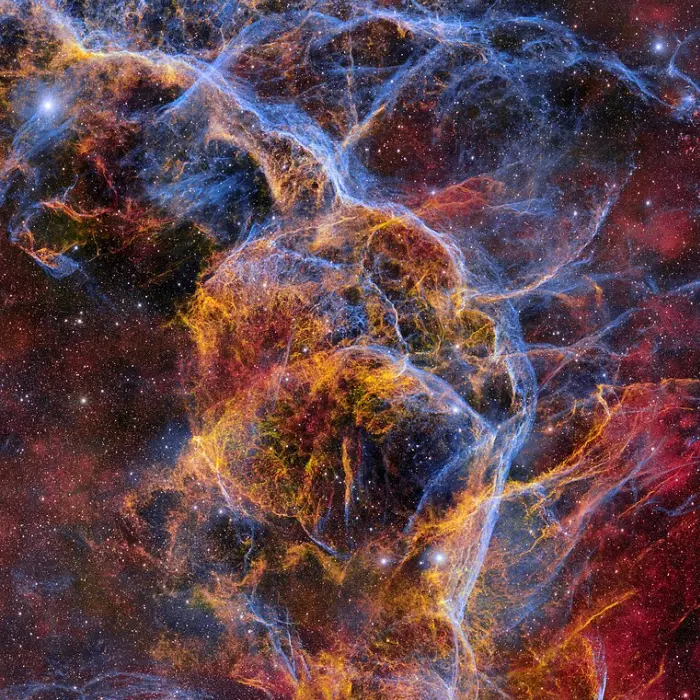
This colorful web of wispy gas filaments is the Vela Supernova Remnant, an expanding nebula of cosmic debris left over from a massive star that went out as a supernova about 11,000 years ago. This image was taken with the Department of Energy-fabricated Dark Energy Camera (DECam), mounted on the US National Science Foundation’s Víctor M. Blanco 4-meter Telescope at Cerro Tololo Inter-American Observatory in Chile, a Program of NSF’s NOIRLab. The striking reds, yellows, and blues in this image were achieved through the use of three DECam filters that each collect a specific color of light. Separate images were taken in each filter and then stacked on top of each other to produce this high-resolution image that contains 1.3 gigapixels and showcases the intricate web-like filaments snaking throughout the expanding cloud of gas. Image credit: CTIO/NOIRLab/DOE/NSF/AURA; Image Processing: T.A. Rector (University of Alaska Anchorage/NSF’s NOIRLab), M. Zamani & D. de Martin (NSF’s NOIRLab) (CC BY 4.0)
The distance to the Vela SNR has long been uncertain. In 1968, Milne estimated a distance of 500 parsecs (1,630 light-years). This was reduced to around 250 pc (815 ly) by Wallerstein & Silk in 1971. In 1999, Cha & Sembach also found a distance of 250 ± 30 pc. The currently accepted value of around 287 parsecs (936 ly) was calculated by Dodson et al. in 2003 based on parallax measurements using very long baseline interferometry (VLBI).
The Vela Supernova Remnant contains the Pencil Nebula, a long, narrow nebula catalogued as NGC 2736 in the New General Catalogue. The nebula was discovered by John Herschel in March 1835. It has a radius of 5 light-years and an apparent size of 30 by 7 arcminutes.
The Pencil Nebula is the brightest part of the Vela SNR. It is believed to have formed from a portion of the shock wave of the supernova remnant. The nebula lies approximately 815 light-years away and is moving at around 644,000 km/s.
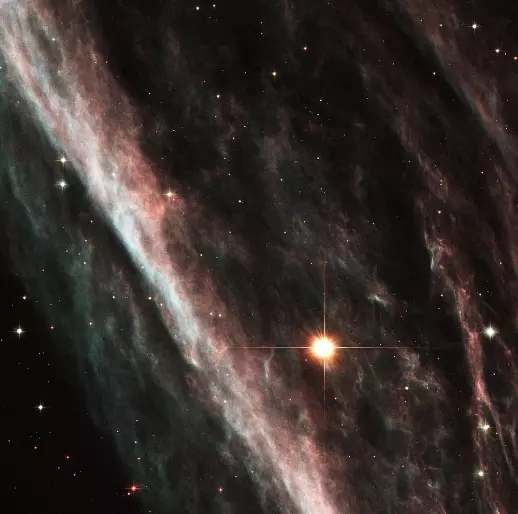
Remnants from a star that went supernova thousands of years ago created a celestial abstract portrait, as captured in this NASA Hubble Space Telescope image of the Pencil Nebula. The nebula’s shape suggests that it is part of the supernova shock wave that recently encountered a region of dense gas. It is this interaction that causes the nebula to glow, appearing like a rippled sheet. In this image, astronomers are looking along the edge of the undulating sheet of gas. This view shows large, wispy filamentary structures, smaller bright knots of gas, and patches of diffuse gas. The Hubble Heritage Team used the Advanced Camera for Surveys in October 2002 to observe the nebula. The region of the Pencil Nebula captured in this image is about three fourths of a light-year across. Image: NASA and The Hubble Heritage Team
The Vela Supernova Remnant lies in the foreground with respect to the much larger Gum Nebula (Gum 12), a vast, faint emission nebula that stretches across an area of 36 degrees. The progenitor star of the Vela SNR is one of the massive stars whose intense radiation eroded away the nebula’s clouds of dust and gas. The other stars responsible for the evaporating clouds are Regor (Gamma2 Velorum) and Naos (Zeta Puppis).
Astronomers explain the asymmetry between the northeastern and southwestern parts of the Vela remnant by the presence of a stellar wind bubble blown by the Wolf-Rayet star in the Gamma2 Velorum system. The hot, massive star is the nearest Wolf-Rayet star to the Sun.
The Vela SNR is also partly superimposed on the Vela Molecular Ridge, a molecular cloud complex that lies 2283 – 3,261 light-years (700 – 1,000 parsecs) away. The complex appears as a sequence of bright and dark nebulae a few degrees northwest of Suhail (Lambda Velorum).
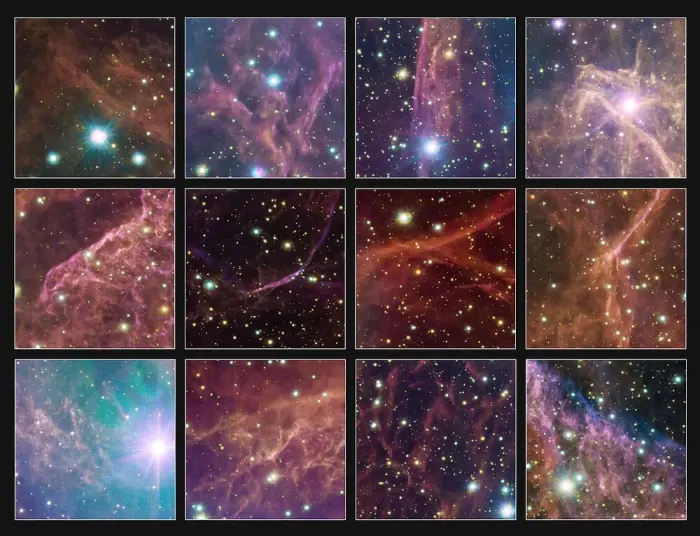
Some of the most interesting objects found within the new 1.3 gigapixel Vela Supernova Remnant image, captured with the Department of Energy-fabricated Dark Energy Camera, mounted on the Víctor M. Blanco 4-meter Telescope at Cerro Tololo Inter-American Observatory in Chile, a Program of NSF’s NOIRLab. Image credit: CTIO/NOIRLab/DOE/NSF/AURA; Image Processing: T.A. Rector (University of Alaska Anchorage/NSF’s NOIRLab), M. Zamani & D. de Martin (NSF’s NOIRLab) (CC BY 4.0)
Vela Pulsar
The Vela Pulsar is the stellar remnant of the progenitor of the Vela Supernova Remnant. The progenitor star went out as a Type II supernova 11,000 years ago, leaving behind an optical, radio, X-ray and gamma ray emitting pulsar that spins 11 times per second.
At the time of discovery, the Vela Pulsar had the shortest period known of any pulsar, only 89.33 milliseconds.
The Vela Supernova Remnant was discovered in the mid-1950s as one of the strongest sources of radio emission in the sky. The radio source was linked to a filamentary nebula visible in optical wavelengths. X-ray images obtained with the ROSAT satellite in the mid-1990s revealed the remnant’s full extent.
The association between the Vela Pulsar and the Vela Supernova Remnant was discovered by M. I. Large, A. E. Vaughan and B. Y. Mills at the University of Sydney, Australia, in 1968. This was the first direct evidence that neutron stars are produced by supernova events.
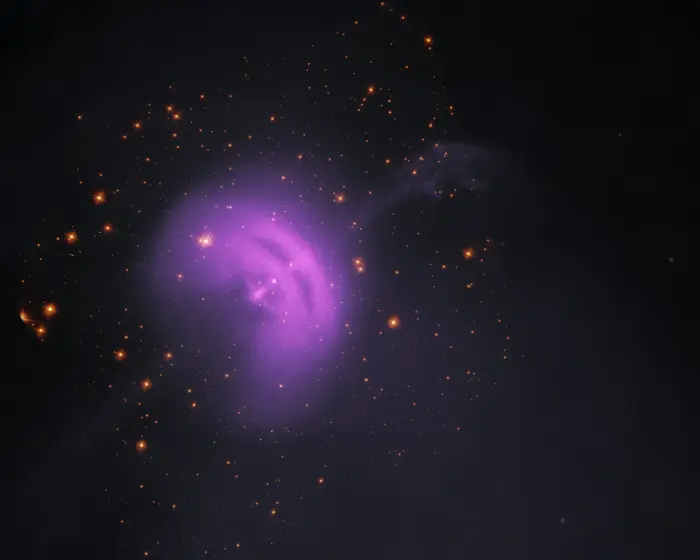
Vela Pulsar, image: Judy Schmidt (CC BY 2.0)
The Vela Pulsar experiences glitches – small increases in the pulsar’s rotational frequency – every three years (on average). The cause of the glitches is unknown, but they have also been observed in the Crab Pulsar, the central neutron star of the brighter and better-known Crab Nebula (Messier 1).
The energy released by the Vela Pulsar drives a pulsar wind nebula, Vela X. The designation Vela X is sometimes also used for the pulsar itself.
A pulsar wind nebula, or a plerion, forms soon after a pulsar is formed. These objects are usually found inside supernova remnants, and they appear as optical, infrared, millimetre, X-ray and gamma-ray sources. They are powered by spinning pulsars. As they spin, pulsars generate exceptionally strong magnetic fields which accelerate the charged particles of the pulsar winds to relativistic speeds.
Like other types of nebulae, pulsar wind nebulae evolve over time. As they age, the material expelled in the supernova event dissipates into the interstellar medium.
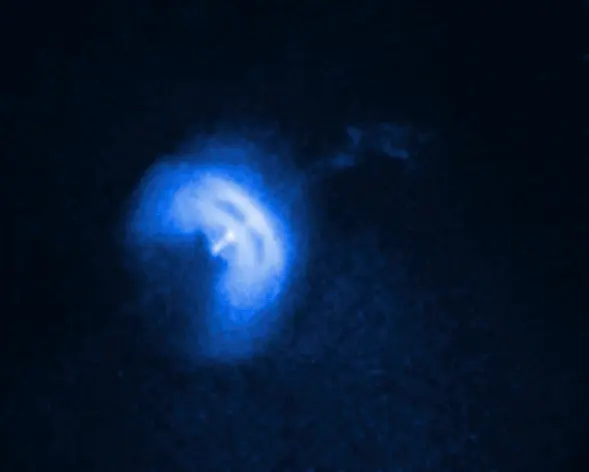
This movie from NASA’s Chandra X-ray Observatory shows a fast moving jet of particles produced by a rapidly rotating neutron star, the Vela Pulsar, and may provide new insight into the nature of some of the densest matter in the universe. The Vela Pulsar is a neutron star that was formed when a massive star collapsed. It is about 1,000 light years from Earth, spans about 12 miles in diameter, and makes over 11 complete rotations every second, faster than a helicopter rotor. As the pulsar whips around, it spews out a jet of charged particles that race out along the pulsar’s rotation axis at about 70% of the speed of light. In this video, the jet emanating from the pulsar is 0.7 light years long. Image credit: NASA/CXC/Univ. of Toronto/M. Durant, et al. (PD)
Facts
The Vela Supernova Remnant is one of the nearest supernova remnants to the solar system. Geminga in the constellation Gemini is closer, at an approximate distance of 815 light-years.
The supernova remnant RX J0852.0−4622 (G266.2−1.2) appears within the older Vela SNR and has been nicknamed Vela Junior. It appears in the southeastern part of the Vela SNR. The smaller remnant was discovered with the ROSAT X-ray telescope in 1998. While some astronomers have proposed that it is a complex part of the larger Vela SNR, most studies support the belief that it is a discrete supernova remnant. Observations with the High Energy Stereoscopic System (HESS) in 2005 strongly confirm this. Vela Junior lies at least 1,630 light-years (500 parsecs) away and has an estimated age of at least 2,400 years.
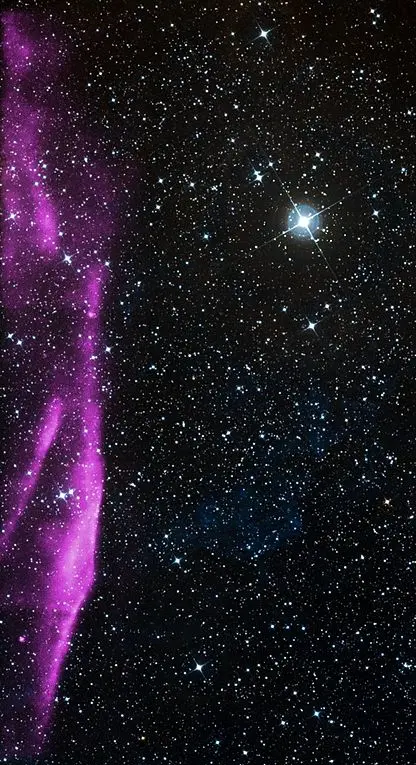
G266.2-1.2 was produced by a supernova in the Milky Way galaxy. A Chandra observation of this supernova remnant reveals the presence of extremely high-energy particles produced as the shock wave expands into interstellar space. In this image, the X-rays from Chandra (purple) have been combined with optical data from the Digitized Sky Survey (red, green, and blue). Image credit: X-ray: NASA/CXC/Morehead State Univ/T.Pannuti et al, Optical: DSS (PD)
The Vela Supernova Remnant overlaps the more distant supernova remnant Puppis A. The two objects appear in the same line of sight but are not physically related. Puppis A is about 100 light-years across and lies approximately 6,500 – 7,000 light-years from the Sun. It appears smaller than the Vela SNR, with an angular diameter of 1 degree. Like the Vela SNR, Puppis A is among the brightest X-ray sources in the sky.
Location
The Vela Supernova Remnant lies near the centre of the triangle formed by the bright stars Regor (Gamma Velorum) and Suhail (Lambda Velorum) in Vela and Naos (Zeta Puppis) in the neighbouring Puppis.
At declination -45°, the Vela Supernova Remnant is visible from locations south of the latitude 44° N. However, it is a challenging target for observers in the mid-northern latitudes because it never rises very high above the horizon.
The remnant is much easier to observe from the southern hemisphere. The constellation Vela (the Sails) appears close to Carina (the Keel) and Puppis (the Stern) in the sky. The three constellations once formed the larger Argo Navis (the Ship Argo), which was divided by the French astronomer Nicolas Louis de Lacaille in the 1750s.
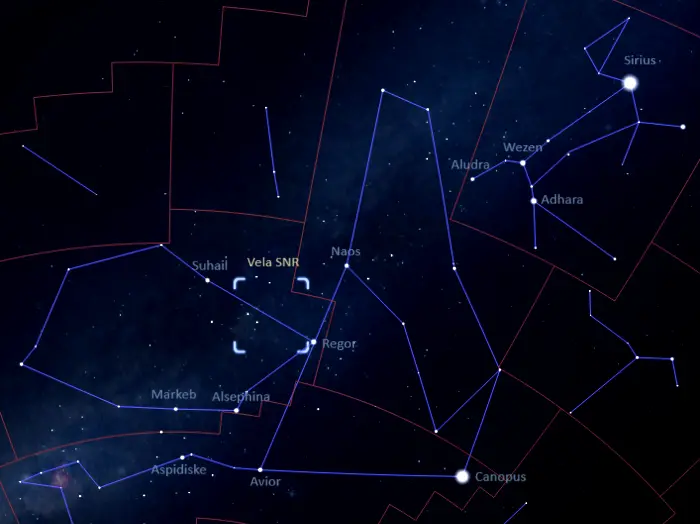
The location of the Vela Supernova Remnant, image: Stellarium
Regor, the brightest star in Vela, forms an almost straight line with Naos in Puppis and Avior in Carina. Regor and Suhail lie near the False Cross, formed by Avior, Aspidiske, Alsephina, and Markeb, and can be identified using these stars.
Deep sky objects that appear in the same region of the sky include the open star clusters NGC 2659, NGC 2645, NGC 2660, IC 2395, and NGC 2670.
The best time of the year to see the Vela Supernova Remnant and other deep sky objects in Vela is in March, when the constellation climbs higher above the horizon in the early evening.
Vela Supernova Remnant
| Constellation | Vela |
| Object type | Supernova remnant |
| Right ascension | 08h 35m 20.66s |
| Declination | −45° 10′ 35.2″ |
| Apparent magnitude | 12 |
| Apparent size | 8 degrees |
| Distance | 936 light-years (287 parsecs); 881 – 998 ly (270 – 306 pc) |
| Names and designations | Vela Supernova Remnant, Vela SNR, SNR G263.9-03.3, SNR G263.4-03.0, SNR G263.9-03.0, Vela XYZ, Gum 16, RE J083854-430902, 2RE J083856-430913, 1E 0840.0-4430, 1ES 0839-44.5, 1FGL J0841.9-4620, GRS G263.90 -03.00 |
Images
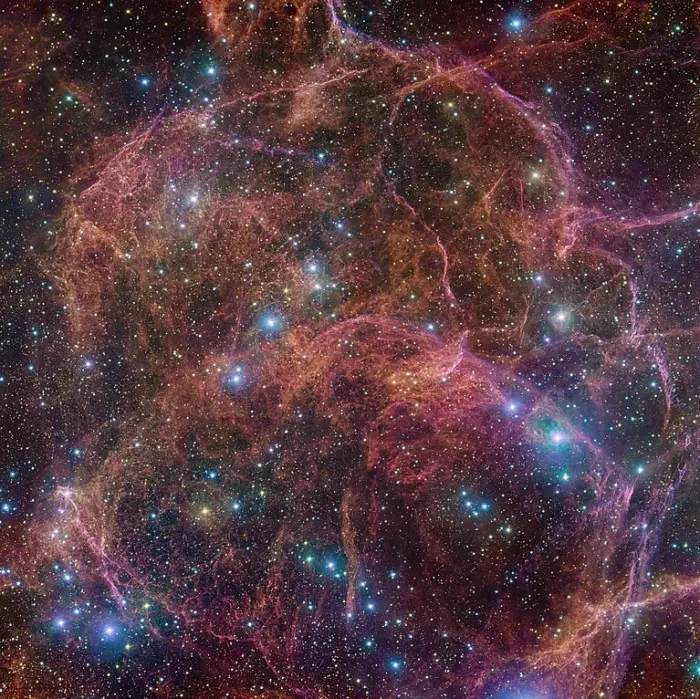
The Vela supernova remnant imaged by the VLT Survey Telescope. The image shows stringy clouds of hot pink and golden orange, nested together all over the frame, almost like the messy fragments of a spider’s web. Close to these colourful clouds, we find bright blue massive stars. In between the clouds there are gaps, revealing stars in blue and yellow, almost like sparklers. This image shows a spectacular view of the orange and pink clouds that make up what remains after the dramatic end of a massive star — the Vela supernova remnant. This detailed image consists of 554 million pixels, and is a combined mosaic image of observations taken with the 268-million-pixel OmegaCAM camera at the VLT Survey Telescope, hosted at ESO’s Paranal Observatory. Image credit: ESO/VPHAS+ team. Acknowledgement: Cambridge Astronomical Survey Unit (CC BY 4.0)
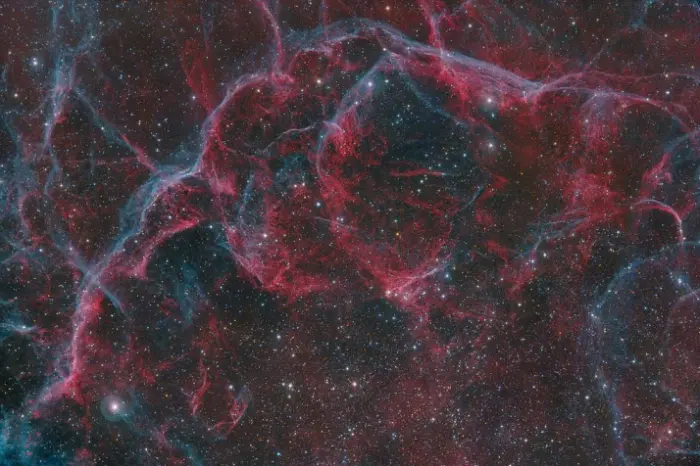
Long exposure photograph of the Vela Supernova Remnant, taken from the Kalahari Desert in Namibia. This image shows the supernova remnant’s northern section. Image: Harel Boren (CC BY-SA 4.0)
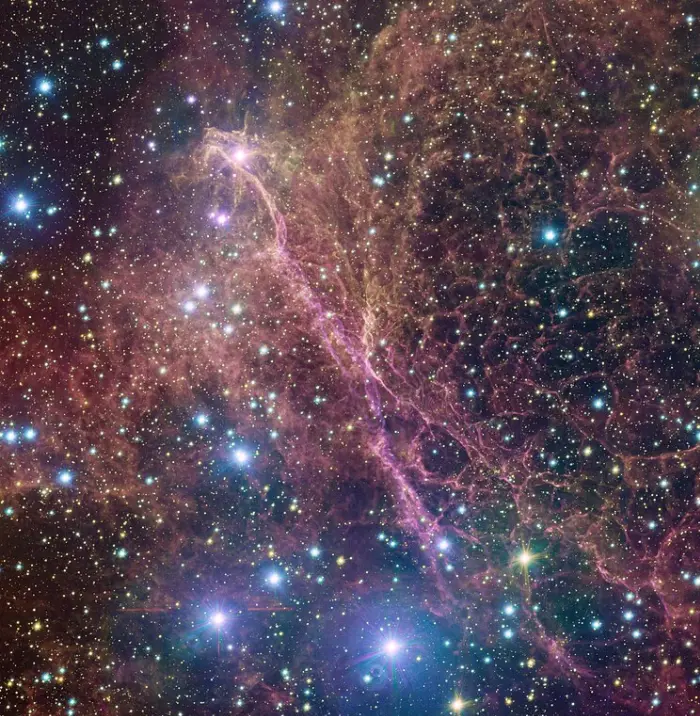
This is a small patch of the Vela supernova remnant, the intricate leftovers of a massive star that went out as a supernova 11 000 years ago. This image is part of a huge and detailed mosaic captured with the VLT Survey Telescope (VST), hosted at ESO’s Paranal Observatory in the Chilean desert. Pink and orange filamentary clouds swarm around in this picture, resembling the ghostly shadow of a cosmic bird with wide orange wings, a long pink body, and a bright pinkish star as an eye. A myriad of stars are sprinkled all over the image. Credit: ESO/VPHAS+ team. Acknowledgement: CASU (CC BY 4.0)
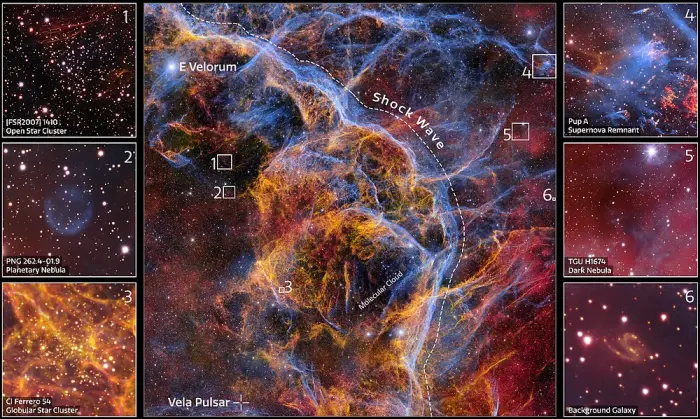
Some of the most interesting objects found within the new 1.3 gigapixel Vela Supernova Remnant image, captured with the Department of Energy-fabricated Dark Energy Camera, mounted on the Víctor M. Blanco 4-meter Telescope at Cerro Tololo Inter-American Observatory in Chile, a Program of NSF’s NOIRLab. Image credit: CTIO/NOIRLab/DOE/NSF/AURA; Image Processing: T.A. Rector (University of Alaska Anchorage/NSF’s NOIRLab), M. Zamani & D. de Martin (NSF’s NOIRLab) (CC BY 4.0)
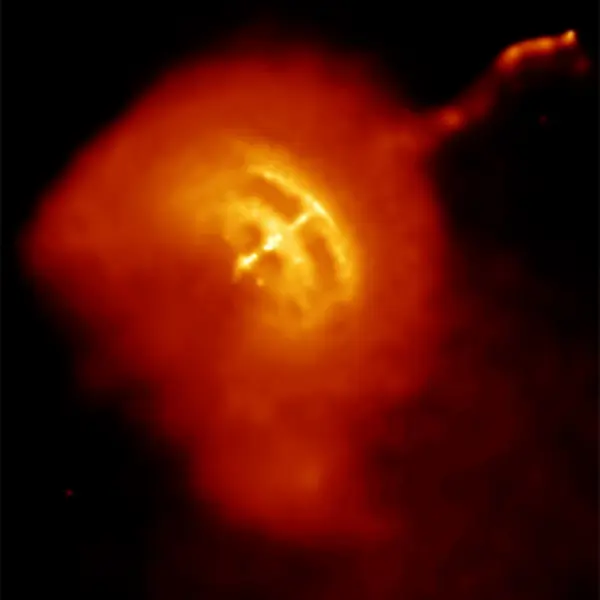
The Vela Pulsar, a neutron star left from a titanic stellar supernova, shoots through space powered by a jet emitted from one of the neutron star’s rotational poles. Now a counter jet in front of the neutron star has been imaged by the Chandra X-ray observatory. The Chandra image above shows the Vela Pulsar as a bright white spot in the middle of the picture, surrounded by hot gas shown in yellow and orange. The counter jet can be seen wiggling from the hot gas in the upper right. Chandra has been studying this jet so long that it’s been able to create a movie of the jet’s motion. The jet moves through space like a firehose, wiggling to the left and right and up and down, but staying collimated: the “hose” around the stream is, in this case, composed of a tightly bound magnetic field. Credit: NASA/CXC/PSU/G.Pavlov et al. (PD)
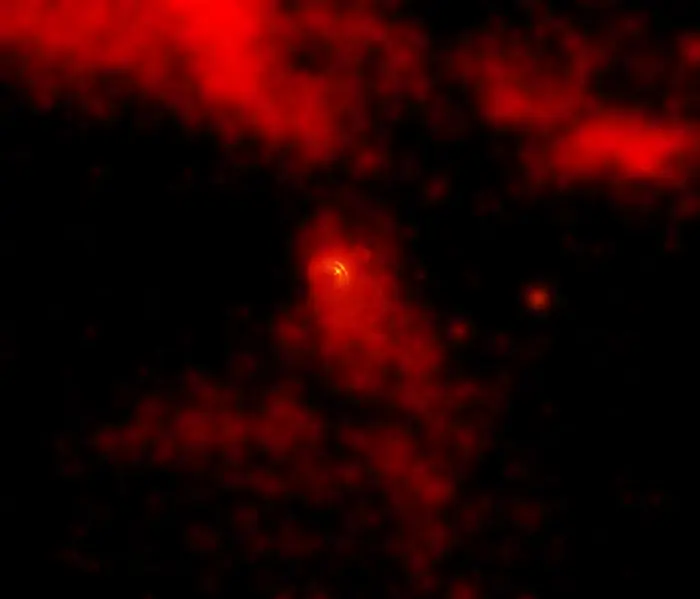
In this wide angle view, the Vela pulsar wind nebula is seen against a background of clouds, or filaments, of multi-million degree Celsius gas. These clouds are part of a huge sphere of hot expanding gas produced by the supernova associated with the creation of the Vela pulsar about 10,000 years ago. As the ejecta from the supernova event expanded into space and collided with the surrounding interstellar gas, shock waves were formed and heated the gas and ejecta to millions of degrees. The sphere of hot gas is about 100 light years across, 15 times larger than the region shown in this image, and is expanding at a speed of about 400,000 km/hr. Credit: NASA/SAO/CXC (PD)
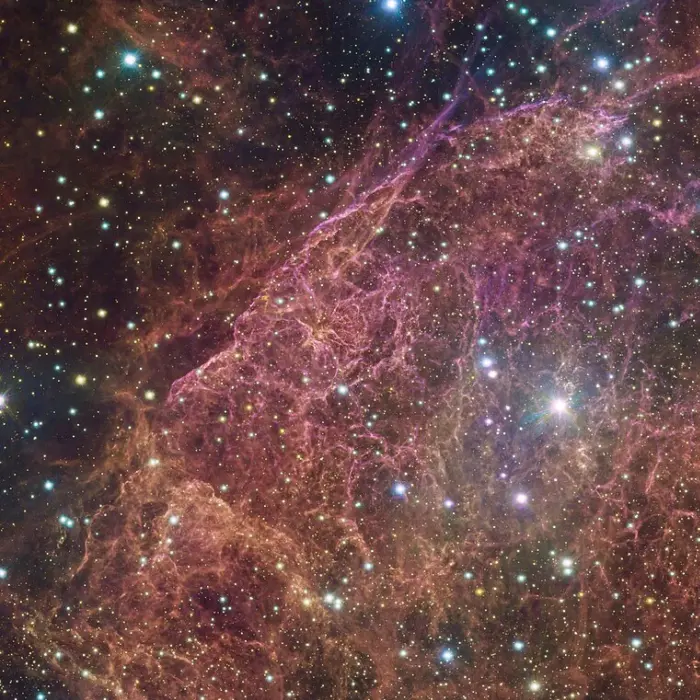
Sometimes dramatic events are needed to create something stunning. This beautiful structure of filaments and clouds in the southern constellation of Vela are all that remains of a massive star that ended its life as a supernova. This is a small section of a larger image taken using the wide-field camera OmegaCAM at the VLT Survey Telescope (VST). Credit: ESO/VPHAS+ team. Acknowledgement: Cambridge Astronomical Survey Unit (CC BY 4.0)
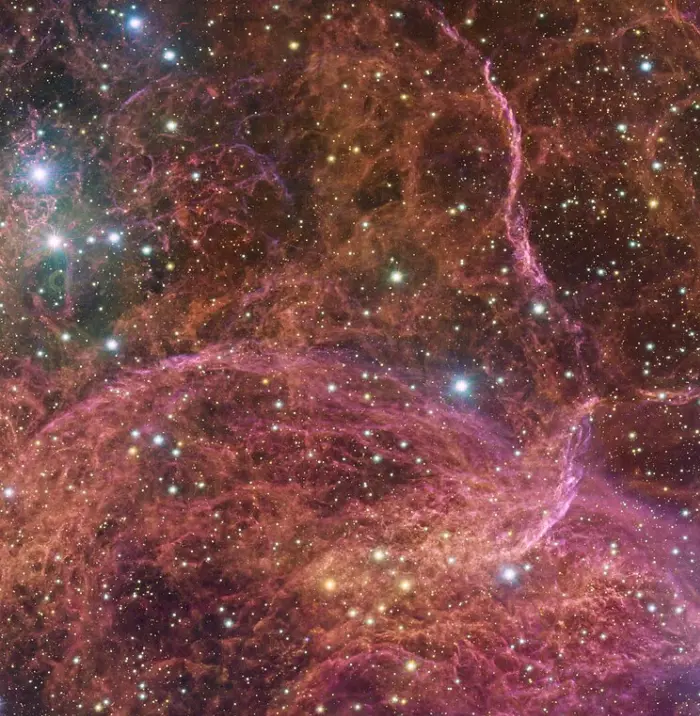
A small portion of the Vela Supernova Remnant, image credit: ESO/VPHAS+ team. Acknowledgement: Cambridge Astronomical Survey Unit (CC BY 4.0)
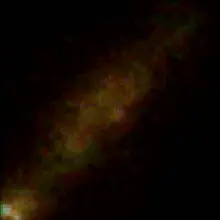
This image shows pulsed gamma rays from the Vela pulsar as constructed from photons detected by Fermi’s Large Area Telescope. The Vela pulsar, which spins 11 times a second, is the brightest persistent source of gamma rays in the sky. The bluer colour in the latter part of the pulse indicates the presence of gamma rays with energies exceeding a billion electron volts (1 GeV). For comparison, visible light has energies between two and three electron volts. Red indicates gamma rays with energies less than 300 million electron volts (MeV); green, gamma rays between 300 MeV and 1 GeV; and blue shows gamma rays greater than 1 GeV. The image frame is 30 degrees across. The background, which shows diffuse gamma-ray emission from the Milky Way, is about 15 times brighter here than it actually is. Credit: Roger Romani (Stanford University) (Lead), Lucas Guillemot (CENBG), Francis Reddy (SPSYS) (PD)